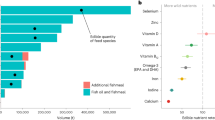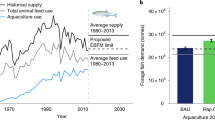Abstract
The production of farmed Atlantic salmon (Salmo salar) is currently linked to finite marine resources, particularly fish oil (FO) and fish meal (FM). Understanding this relationship in a quantitative manner is imperative if this critical balance is to be maintained within sustainable limits as the industry grows. Here we project the potential production and associated growth of the Atlantic salmon aquaculture industry on the basis of a variety of FO and FM utilization scenarios in aquafeed. Reducing FO and FM dietary inclusion to 3% each could permit production growth of 2% per year until the turn of the century (2097 and beyond 2100, respectively), independent of a host of alternatives now being utilized—with three portions of salmon per week providing almost all the recommended weekly long-chain omega-3 fatty acids for human intake. The Atlantic salmon industry’s positive annual growth can continue in an era of finite marine resource availability—without the need for additional finite marine resource inputs.
This is a preview of subscription content, access via your institution
Access options
Access Nature and 54 other Nature Portfolio journals
Get Nature+, our best-value online-access subscription
$29.99 / 30 days
cancel any time
Subscribe to this journal
Receive 12 digital issues and online access to articles
$119.00 per year
only $9.92 per issue
Buy this article
- Purchase on Springer Link
- Instant access to full article PDF
Prices may be subject to local taxes which are calculated during checkout




Similar content being viewed by others
References
The State of World Fisheries and Aquaculture 2020: Sustainability in Action (FAO, 2020); https://doi.org/10.4060/ca9229en
Fish to 2030: Prospects for Fisheries and Aquaculture (World Bank, 2013).
OECD–FAO Agricultural Outlook 2020–2029 (OECD and FAO, 2020).
Turchini, G. M., Trushenski, J. T. & Glencross, B. D. Thoughts for the future of aquaculture nutrition: realigning perspectives to reflect contemporary issues related to judicious use of marine resources in aquafeeds. N. Am. J. Aquac. 81, 13–39 (2019).
Fishmeal and Fish Oil—Case Study Monthly Highlights No. 4/2019, 43 (EUMOFA, 2019).
Tacon, A. G. J. & Metian, M. Global overview on the use of fish meal and fish oil in industrially compounded aquafeeds: trends and future prospects. Aquaculture 285, 146–158 (2008).
Cao, L. et al. China’s aquaculture and the world’s wild fisheries. Science 347, 133–135 (2015).
Aranda, M. Developments on fisheries management in Peru: the new individual vessel quota system for the anchoveta fishery. Fish. Res. 96, 308–312 (2009).
Shepherd, C. J. & Jackson, A. J. Global fishmeal and fish-oil supply: inputs, outputs and markets. J. Fish Biol. 83, 1046–1066 (2013).
Cottrell, R. S., Blanchard, J. L., Halpern, B. S., Metian, M. & Froehlich, H. E. Global adoption of novel aquaculture feeds could substantially reduce forage fish demand by 2030. Nat. Food 1, 301–308 (2020).
Froehlich, H. E., Jacobsen, N. S., Essington, T. E., Clavelle, T. & Halpern, B. S. Avoiding the ecological limits of forage fish for fed aquaculture. Nat. Sustain. 1, 298–303 (2018).
Turchini, G. M. Fish oils, misconceptions and the environment. Am. J. Public Health 103, e4 (2013).
Schreiber, M. A. & Halliday, A. Uncommon among the commons? Disentangling the sustainability of the Peruvian anchovy fishery. Ecol. Soc. 18, 12 (2013).
Tacon, A. G. J. & Metian, M. Fishing for feed or fishing for food: increasing global competition for small pelagic forage fish. Ambio 38, 294–302 (2009).
Aas, T. S., Ytrestøyl, T. & Åsgård, T. Utilization of feed resources in the production of Atlantic salmon (Salmo salar) in Norway: an update for 2016. Aquac. Rep. 15, 100216 (2019).
Shepherd, C. J., Monroig, O. & Tocher, D. R. Future availability of raw materials for salmon feeds and supply chain implications: the case of Scottish farmed salmon. Aquaculture 467, 49–62 (2017).
Tocher, D. R. Omega-3 long-chain polyunsaturated fatty acids and aquaculture in perspective. Aquaculture 449, 94–107 (2015).
Sissener, N. H. Are we what we eat? Changes to the feed fatty acid composition of farmed salmon and its effects through the food chain. J. Exp. Biol. 221, jeb161521 (2018).
Sprague, M., Dick, J. R. & Tocher, D. R. Impact of sustainable feeds on omega-3 long-chain fatty acid levels in farmed Atlantic salmon, 2006–2015. Sci. Rep. 6, 21892 (2016).
Hertrampf, J. W. & Piedad-Pascual, F. Handbook on Ingredients for Aquaculture Feeds (Kluwer Academic, 2000).
Sargent, J. & Tacon, A. Development of farmed fish: a nutritionally necessary alternative to meat. Proc. Nutr. Soc. 58, 377–383 (1999).
Turchini, G. M., Nichols, P. D., Barrow, C. & Sinclair, A. J. Jumping on the omega-3 bandwagon: distinguishing the role of long-chain and short-chain omega-3 fatty acids. Crit. Rev. Food Sci. Nutr. 52, 795–803 (2012).
Ghasemifard, S., Wang, F., Sinclair, A. J., Elliott, G. & Turchini, G. M. How does high DHA fish oil affect health? A systematic review of evidence. Crit. Rev. Food Sci. Nutr. 59, 1684–1727 (2019).
EFSA Panel on Dietetic Products, Nutrition and Allergies (NDA) Scientific opinion on the tolerable upper intake level of eicosapentaenoic acid (EPA), docosahexaenoic acid (DHA) and docosapentaenoic acid (DPA). EFSA J. 10, 2815 (2012).
Kris-Etherton, P. M., Grieger, J. A. & Etherton, T. D. Dietary reference intakes for DHA and EPA. Prostaglandins Leukot. Essent. Fatty Acids 81, 99–104 (2009).
Global Recommendations for EPA and DHA Intake (GOED, 2014).
GOED Publishes EPA and DHA Intake Recommendations (GOED, 2016).
Ghasemifard, S., Sinclair, A. J., Kaur, G., Lewandowski, P. & Turchini, G. M. What is the most effective way of increasing the bioavailability of dietary long chain omega-3 fatty acids—daily vs. weekly administration of fish oil? Nutrients 7, 5628–5645 (2015).
Cottrell, R. S. et al. Time to rethink trophic levels in aquaculture policy. Rev. Aquac. https://doi.org/10.1111/raq.12535 (2021).
Shepherd, C. & Little, D. Aquaculture-are the criticisms justified? Environmental impacts and use of resources with special reference to farming Atlantic salmon. World 4, 37–52 (2014).
Tacon, A. G. J. & Metian, M. Feed matters: satisfying the feed demand of aquaculture. Rev. Fish. Sci. Aquac. 23, 1–10 (2015).
Mock, T. S. et al. Seasonal effects on growth and product quality in Atlantic salmon fed diets containing terrestrial oils as assessed by a long-term, on-farm growth trial. Aquac. Nutr. https://doi.org/10.1111/anu.13200 (2020).
Jackson, A. & Newton, R. W. Project to Model the Use of Fisheries By-products in the Production of Marine Ingredients with Special Reference to the Omega 3 Fatty Acids, EPA and DHA (IFFO, 2016).
Wijkström, U. N. Is feeding fish with fish a viable practice? in Farming the Waters for People and Food: Proc. Global Conference on Aquaculture 2010 (eds Subasinghe, R.P. et al.) 33–55 (FAO and NACA, 2012).
The Evolution of Sustainability Metrics for Marine Ingredients—New (IFFO, 2022); https://www.iffo.com/evolution-sustainability-metrics-marine-ingredients-new
Colombo, S. M. & Turchini, G. M. ‘Aquafeed 3.0’: creating a more resilient aquaculture industry with a circular bioeconomy framework. Rev. Aquac. 13, 1156–1158 (2021).
Asche, F. & Tveterås, S. On the relationship between aquaculture and reduction fisheries. J. Agric. Econ. 55, 245–265 (2004).
Alder, J., Campbell, B., Karpouzi, V., Kaschner, K. & Pauly, D. Forage fish: from ecosystems to markets. Annu. Rev. Environ. Resour. 33, 153–166 (2008).
Welch, A. et al. From fishing to the sustainable farming of carnivorous marine finfish. Rev. Fish. Sci. 18, 235–247 (2010).
Tanner, J. E. Southern Bluefin Tuna Aquaculture Subprogram: Tuna Environment Subproject—Development of Regional Environmental Sustainability Assessments for Tuna Sea-Cage Aquaculture Project No. 2001/104 (FRDC, 2007).
Jeffriess, B. A Review of Tuna Growth Performance in Ranching and Farming Operations (ASBTIA, 2015).
Kaushik, T. & Max, S. Taking the fish-in fish-out ratio a step further. Aquac. Eur. 35, 15–17 (2010).
Bou, M. et al. Requirements of n-3 very long-chain PUFA in Atlantic salmon (Salmo salar L): effects of different dietary levels of EPA and DHA on fish performance and tissue composition and integrity. Br. J. Nutr. 117, 30–47 (2017).
NRC Nutrient Requirements of Fish and Shrimp (National Academies Press, 2011); https://doi.org/10.17226/13039
Rosenlund, G., Torstensen, B. E., Stubhaug, I., Usman, N. & Sissener, N. H. Atlantic salmon require long-chain n-3 fatty acids for optimal growth throughout the seawater period. J. Nutr. Sci. 5, e19 (2016).
Mock, T. S. et al. A systematic review and analysis of long-term growth trials on the effect of diet on omega-3 fatty acid levels in the fillet tissue of post-smolt Atlantic salmon. Aquaculture 516, 734643 (2020).
Mock, T. S. et al. The impact of dietary protein:lipid ratio on growth performance, fatty acid metabolism, product quality and waste output in Atlantic salmon (Salmo salar). Aquaculture 501, 191–201 (2019).
Sanden, M., Stubhaug, I., Berntssen, M. H. G., Lie, Ø. & Torstensen, B. E. Atlantic salmon (Salmo salar L.) as a net producer of long-chain marine ω-3 fatty acids. J. Agric. Food Chem. 59, 12697–12706 (2011).
Fishery and Aquaculture Statistics (FishStatJ) (FAO Fisheries and Aquaculture Division, 2022).
Ytrestøyl, T., Aas, T. S. & Åsgård, T. Utilisation of feed resources in production of Atlantic salmon (Salmo salar) in Norway. Aquaculture 448, 365–374 (2015).
Acknowledgements
The authors received no specific funding for this work.
Author information
Authors and Affiliations
Contributions
D.S.F. and G.M.T. conceptualized the subject. M.M.R. quantified and conducted the analyses, wrote the original manuscript and produced the figures. M.M.R., D.S.F. and T.S.M. contributed to the interpretation and expansion of the subject. M.M.R., D.S.F., T.S.M. and G.M.T. contributed to reviewing and editing the manuscript.
Corresponding author
Ethics declarations
Competing interests
The authors declare no competing interests.
Peer review
Peer review information
Nature Food thanks Albert Tacon and the other, anonymous, reviewer(s) for their contribution to the peer review of this work.
Additional information
Publisher’s note Springer Nature remains neutral with regard to jurisdictional claims in published maps and institutional affiliations.
Supplementary information
Supplementary Information
Supplementary Table 1 and supplementary data and code file names.
Supplementary Data 1
Statistical source data for Figs. 1, 3 and 4.
Supplementary Code 1
Code for Figs. 1, 3 and 4.
Rights and permissions
Springer Nature or its licensor holds exclusive rights to this article under a publishing agreement with the author(s) or other rightsholder(s); author self-archiving of the accepted manuscript version of this article is solely governed by the terms of such publishing agreement and applicable law.
About this article
Cite this article
Rocker, M.M., Mock, T.S., Turchini, G.M. et al. The judicious use of finite marine resources can sustain Atlantic salmon (salmo salar) aquaculture to 2100 and beyond. Nat Food 3, 644–649 (2022). https://doi.org/10.1038/s43016-022-00561-4
Received:
Accepted:
Published:
Issue Date:
DOI: https://doi.org/10.1038/s43016-022-00561-4
This article is cited by
-
New alternative ingredients and genetic selection are the next game changers in rainbow trout nutrition: a metabolomics appraisal
Scientific Reports (2023)
-
Nutrient footprint versus EPA + DHA security in land-locked regions—more of local pond farmed, imported marine fish or fish oil capsules?
npj Science of Food (2023)
-
Evaluation of long-chain omega-3 canola oil on Atlantic salmon growth, performance, and essential fatty acid tissue accretion across the life cycle: a review
Aquaculture International (2023)



